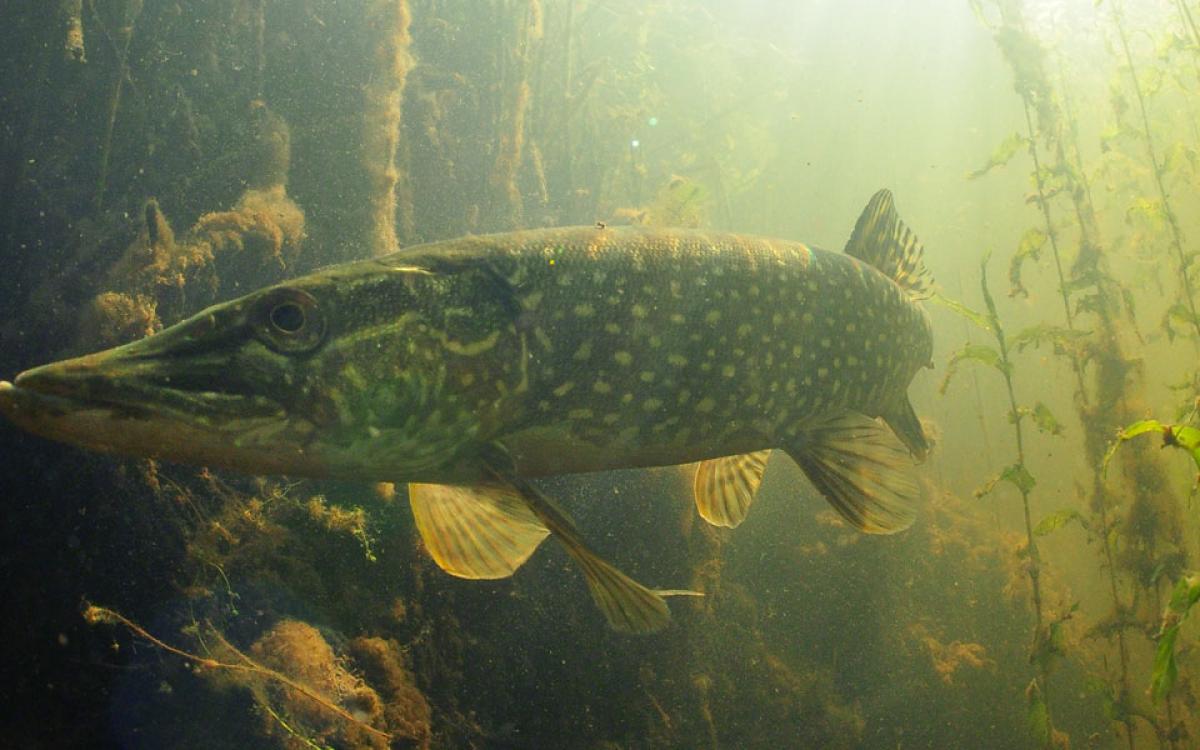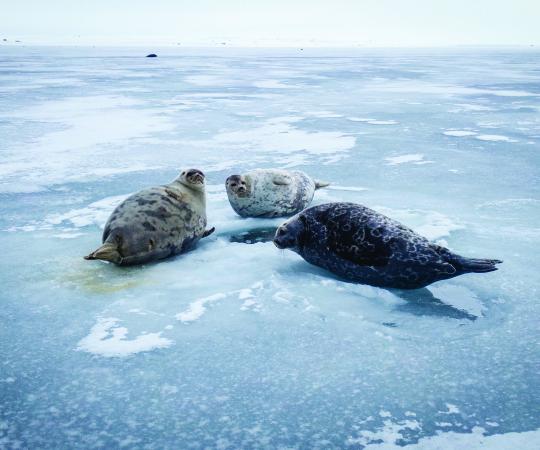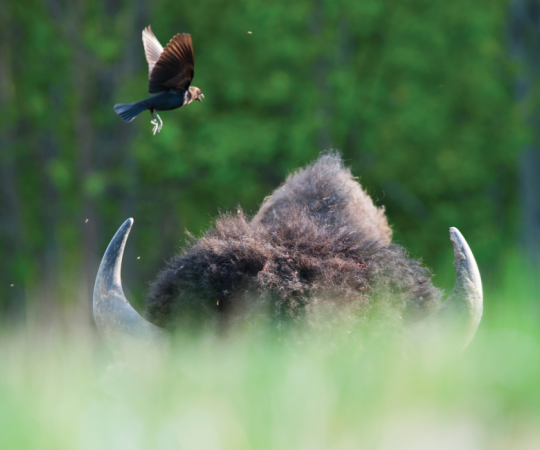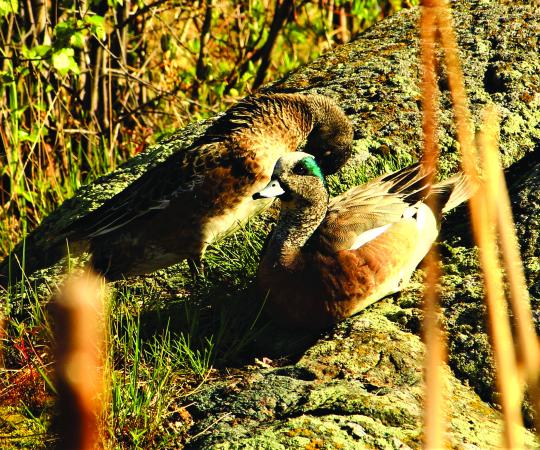You grow up eating a lot of fish in the North. “Everything is so fresh,” says Doug Lamalice, who doesn’t have to travel far from his K’atl’odeeche First Nation home to catch one. There’s walleye in the Hay River, Northern pike at its mouth, whitefish a few miles west in Great Slave Lake. “We’re so spoiled in that way and we take it for granted.” But we shouldn’t. In this guide, fish lovers tell us all about nine of our most iconic species: where to find them, how best to prepare them and thereby respect them.

Northern Pike
Chances are if you’ve done any fishing North of 60, you caught a pike. Ubiquitous in lakes across the mainland in all three territories, the long, slimy jackfish will take a bite out of just about anything—so maybe don’t dangle your ring finger out of the canoe. Though a Northern pike can be tricky to de-bone, don’t let that or its threatening mug deter you from frying it up for lunch.
Where are they? Pike are ambush predators and hunt in shallow water where they can lurk in reeds, or hide behind logs or rocks and sneak up on their prey. That partly explains its camouflaged colour, says ichthyologist Paul Vecsei. “It can stay motionless and hidden, waiting for predators to come by and then it strikes.” And its appetite is staggering—be it an adult inconnu or dozens of ciscoes.
Getting hooked: If you’re fishing from shore, pike are your best bet. They really are indiscriminate eaters, so don’t worry about bait or a fancy lure—a ‘five of diamonds’ should do you just fine. But be sure to have some pliers on hand. Remember, you’re supposed to be eating it, not the other way around.
Good eating: Maybe it’s due to their sliminess or because people find them tough to fillet because of their Y-bones, but Northerners tend to keep pike off their dinner tables. And that’s too bad. In fact, Vecsei will put its meat up against any other fish out there. “In Europe, they’re obsessed with eating it,” he says. “It’s an upper-upper-class thing.” It’s true—order quinelles de brochet at a fancy French restaurant and the uptight waiter will soon be serving you pike dumplings.

Arctic Char
This is the iconic fish of Inuit—in fact, its name ikaluq is interchangeable with ‘fish’ in Inuktitut. Arctic char spend the majority of their lives in the ocean and they will migrate in-land in the summer or fall to spawn in lakes. There, they will overwinter before heading back out to the sea. Young char mature in freshwater and eventually leave for the ocean four or five years later.
Where are they? Arctic char are the northernmost freshwater fish in the world. They start to arrive in lakes from August onwards. Males will get there first to establish their territory and then court females, who dig a nest and deposit their eggs.
Getting hooked: You can jig for Arctic char in lakes over winter. During their run, you can choose between your fly-fishing rod or the traditional rod and reel, depending on where you are. Malaya Qaunirq Chapman, host of the Niqitsiat cooking show with Rebecca Veevee, says her great-grandmother always used a piece of red yarn on her hook to lure Arctic char. “She’d also tell me to go fishing in a really happy mood so that the fish will sense your energy,” she says. If you ever get a chance to cast for char on the tundra, you won’t have to try hard to feel contented.
Good eating: Arctic char has long been a staple food for Inuit and because of that, it’s eaten many ways. Pipsi is one of the most popular—brined, cubed and dried and eaten right off the skin. You can also smoke char, candy it, make jerky or cut it into steaks. If you get it cold-smoked, freeze it and then carefully cut the char into thin slices and dip it in soya sauce. At least that’s what members of Iqaluit’s Jerry Cans will recommend when you visit them.
Char, bannock-fried: Mona Netser of Coral Harbour explains her preferred way of eating Arctic char: deep-fried in bannock. “I take the skin off and make it into bite-sized chunks,” she says. For the bannock, take a few cups of flour, some baking powder and salt—“Baffin area, they don’t put any salt in their bannock but a lot of people in Kivalliq region do.” Don’t ask how much of each ingredient to use. “I don’t use measurement,” she laughs. Then add spices. “If you want sweet, put a little bit of sweetness in there.” Now, add an egg if you want and some water too. You want it kind of watery. “Almost like pancake mix,” she says. Dip in the bits and put them in the deepfrier or fry them up in oil on a Coleman stove if you’re camping. “Now you’re making me hungry.”

Whitefish
The North is home to several species of whitefish. There’s the pygmy: “It’s tiny. Itty-bitty,” says Vecsei. “Like finger-sized.” Then there’s the round whitefish, which is common but typically only grows to about 10 inches in length. There’s also the humpback whitefish, found primarily in the Yukon. But if you pull up a chair at most any Northern eatery, it’s the lake whitefish you’re going to find on the menu.
Where are they? “Temperature, frankly, dictates to a large degree whether they’re going to be very deep or in the shallows,” says Vecsei. In spring, when the ice is out, they’re all over. “They can be in five, six feet of water.” In the summer, they move into deeper water. In fall, you’ll find big concentrations of them on rocky shoals in lakes where they spawn, while “another subset run up into the river systems to spawn in rapids or below waterfalls.”
Getting hooked: Here’s what seems to work at Tartan Rapids, where whitefish from Great Slave Lake go to spawn in the fall. Fishers have a bobber with a split-shot weight and then what “looks like a grub or almost like a bloodworm,” says Vecsei. “It’s just like red yarn wrapped around a hook with a bead, a bronze or gold bead, for the head, and that’s just killer.”
Good eating: You can’t really go wrong with whitefish. It’s as simple as frying a fillet—or grilling it or baking it—with lemon, herbs, garlic and butter. Or you could spice things up with some paprika. You can also sweeten it with brown sugar. Why not just experiment with flavours after picking up five fillets for $20 at Barry Buckley’s fish truck in downtown Yellowknife?

Lake Trout
Lake trout are found throughout the territories, ranging as far as the northern reaches of Victoria and Banks islands. Great Bear Lake is the true mecca of lake trout fishing though. The massive beasts, who sometimes live into their fifties, cruise the lake for prey, drawing anglers from all over the world.
Where are they? The prevailing wisdom is lake trout are deepwater fish, but that’s not quite so up here, where the waters are colder than in the south. “They can be in the shallows in the early spring after ice-out or in the fall,” says Vecsei. “They’ll be just about everywhere, except in the shallow weedy bays where the pike are.”
Getting hooked: Sure, if you’re fishing for lake trout mid-summer on the East Arm of Great Slave Lake, you might come armed with downriggers. Otherwise, you don’t need them. “The fish in the North stay at least at the first drop-off, so you’re fishing in 10 to 20 feet of water with sinking lines,” says Steve Hahn, a fly-fishing guide and owner of Headwaters 2 Ocean Troutfitter. “You don’t get the big honking 40-pounders, but 10- to 15- to 20-pound fish are just absolutely
awesome.”
Good eating: Tony Jeffers, a 25-year veteran guide at Plummer’s Great Bear Lake Lodge, does a mean honey garlic baked trout. Like all good things, it involves a tremendous amount of butter—an eight-pound trout means a half-pound of butter. “This is definitely not low calorie,” he says. He pats butter in the bottom of a tin foil packet and then lays his fillets on top. He then rubs granulated garlic and real honey on top, before adding—you guessed it—more butter. He seals the packets up and puts them on the grill over the fire. “You can hear it bubbling inside the tin foil, and after the steam comes out for maybe 10 minutes, it’s done.”

Arctic Grayling
The long, fan-like dorsal fin is the defining feature of the Arctic grayling. The mesmerizingly coloured fish rarely grows larger than four pounds and is found in abundance in clear and cold Northern water bodies, because it doesn’t cope well in silted or polluted environments.
Where are they? Grayling spawn in spring and they’re very widespread across the NWT, the Yukon and Nunavut’s Kitikmeot and Kivalliq regions. Some live in lakes and move to rivers or streams to spawn, “but then there’s some that live in streams and rivers, and those just simply move within the system to their spawning areas,” says Vecsei.
Getting hooked:
To adapt a played out adage: it’s not the size of the grayling in the fight, but the size of the fight in the grayling. Warren LaFave owns the fly-in Inconnu Lodge in the Yukon, about 70 kilometres west of Nahanni National Park.
There’s a creek at the end of his lodge’s lake where you can hit grayling after grayling. What if other fish, pound-for-pound, fought like them? “Holy, the pike and the lake trout would rip your line apart,” he says. “They fly out of the water. They’re a wonderful aerobatic little fish.” Since grayling feed primarily on insects, they’re a favourite for fly-fishers.
Good eating:
If you catch one and you’re hungry, you should probably get it filleted and crackling in the frying pan pronto. “If you leave the fish in the boat for an hour, boom, the meat will just turn to mush,” says LaFave. It’s not a fish you’ll want to keep for long-term freezing either. Hey, since Arctic grayling love pristine water, you might as well eat it fresh anyways.

Burbot
Burbot are bottom-feeders. That’s not a reflection of their character; just where they spend much of their time, feasting on invertebrates, insects and larvae. Long and nearly eel-like in appearance, burbot—known through much of the North as loche—are the only freshwater cod. They have a single-chin barbule that’s often mistaken for a feeler. In reality, it’s a taster. “It’s like having a dangling tongue,” says Vecsei, which burbot use to taste things along the lake bottom as they search for food.
Where are they? Burbot aren’t glued to the bottom of the lake all the time. In summer, they’ll move up in the water column after sundown to feed on small fish. They’re actually more active at night in general.
Getting hooked: “They’re loved by anglers in winter who catch them through the ice in often very shallow water because they move into the shallows in late-winter to spawn,” says Vecsei. Head out with some ciscoes for bait, some good company and patience and you’ll likely be rewarded.
Good eating: At Yellowknife’s Bullocks Bistro, you can order burbot—sold as Great Slave Cod—deep-fried or pan-fried. Either way, you won’t be disappointed with what co-owner Jo-Ann Martin calls their ‘wow fish.’ “When we fillet it, it’s like a pair of pants—it’s massive fillets,” she says. “When we deep fry it with the batter and everything, it comes out and it’s like hanging out over both sides of our plate.” Burbot has the same texture and succulence as traditional ocean cod and Martin likens its culinary adaptability to tofu. “It just takes on any seasoning you put on it. It soaks it right up and flavours itself really well,” she says.

Walleye
This is an NWT fish through and through. Mistakenly called pickerel, walleye are identifiable by their prominent and spiky dorsal fin. These fish have sensitive vision—they can actually see pretty well under starlight. As a result, they tend to frequent shaded areas or deeper water during daylight hours.
Where are they? You’re not going to find walleye in Nunavut or the Yukon. In the North, they’re generally confined to Great Slave Lake and its drainage basin. “In other words, the upper outlet of the Mackenzie River and surrounding small lakes as well,” says Vecsei.
Getting hooked: Walleye will go from deeper water in the day to shallow water at night to feed. “Anglers who are wise to their ways will usually be fishing for them in the low light hours in the evening or very early in the morning when they’re still feeding more heavily than in the middle of the day,” says Vecsei.
Good eating: If you take a walleye, try making ceviche. Cut a fillet or two up into small chunks and marinate them in lemon juice and salt for a few hours in a cold place. Then chop up some cilantro, red onion, tomatoes and peppers into a salsa. Add the fish and eat with chips.

Chum Salmon
Chum don’t tend to rank very high on the list of favoured salmon species. They’re certainly not revered like the Chinook salmon. In fact, some even refer to chum as dog salmon—as in dog food. But that might soon change. “We haven’t been able to fish for Chinook on the Yukon River and tributaries for four years now,” says fly-fishing enthusiast Steve Hahn. And with chum returning in droves, they are finally gaining some appreciation.
Where are they? Chum salmon live in the ocean and come up-river to spawn in fall. “I went to see some at Kluane Lake in early November,” says Vecsei. “There’s basically snow on the ground in a lot of areas, when they’re showing up on their spawning grounds.”
Getting hooked: “We had a bumper crop last year and we didn’t have anybody fishing for them,” says Hahn, who also owns North America’s only “tiny house fly-shop.” But that’s mainly due to lack of marketing, because chum are a “tackle-busting fish.” The key is finding a big gaudy fly, lime-green, orange or red in colour, and then using a “rip-and-strip philosophy.” First, cast out at a 45 degree angle downstream. “Let your fly sink in front of the salmon and then strip back towards you at the end of the swing and hopefully the salmon bites.”
Good eating? Here lies the difference between Chinook and chum. “The meat quality is in a whole other world,” says Vecsei. Chum meat isn’t bright red, nor is it as fatty as Chinook. But it’s good chowder fodder. And Hahn says they smoke up well.









